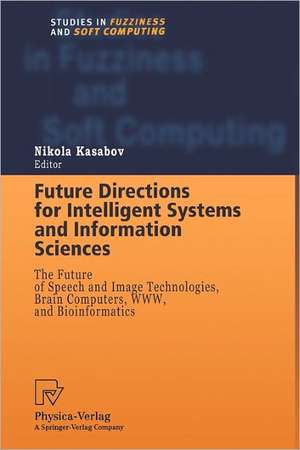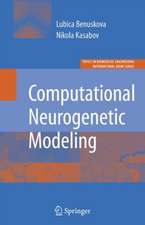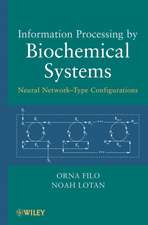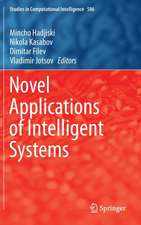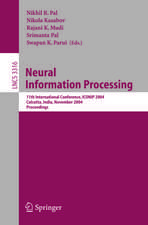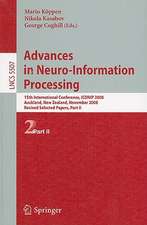Future Directions for Intelligent Systems and Information Sciences: The Future of Speech and Image Technologies, Brain Computers, WWW, and Bioinformatics: Studies in Fuzziness and Soft Computing, cartea 45
Editat de Nikola Kasaboven Limba Engleză Paperback – 21 oct 2010
| Toate formatele și edițiile | Preț | Express |
|---|---|---|
| Paperback (1) | 993.28 lei 6-8 săpt. | |
| Physica-Verlag HD – 21 oct 2010 | 993.28 lei 6-8 săpt. | |
| Hardback (1) | 999.72 lei 6-8 săpt. | |
| Physica-Verlag HD – 4 aug 2000 | 999.72 lei 6-8 săpt. |
Din seria Studies in Fuzziness and Soft Computing
- 20%
 Preț: 999.85 lei
Preț: 999.85 lei - 20%
 Preț: 653.06 lei
Preț: 653.06 lei - 20%
 Preț: 872.98 lei
Preț: 872.98 lei - 20%
 Preț: 930.57 lei
Preț: 930.57 lei - 20%
 Preț: 1051.00 lei
Preț: 1051.00 lei - 20%
 Preț: 992.44 lei
Preț: 992.44 lei - 20%
 Preț: 655.85 lei
Preț: 655.85 lei - 20%
 Preț: 1001.86 lei
Preț: 1001.86 lei - 18%
 Preț: 954.14 lei
Preț: 954.14 lei - 20%
 Preț: 330.10 lei
Preț: 330.10 lei - 20%
 Preț: 333.04 lei
Preț: 333.04 lei - 20%
 Preț: 997.56 lei
Preț: 997.56 lei -
 Preț: 391.61 lei
Preț: 391.61 lei - 20%
 Preț: 647.79 lei
Preț: 647.79 lei - 20%
 Preț: 986.01 lei
Preț: 986.01 lei - 18%
 Preț: 958.56 lei
Preț: 958.56 lei - 20%
 Preț: 996.40 lei
Preț: 996.40 lei - 20%
 Preț: 999.35 lei
Preț: 999.35 lei - 15%
 Preț: 646.43 lei
Preț: 646.43 lei - 20%
 Preț: 651.57 lei
Preț: 651.57 lei - 20%
 Preț: 997.89 lei
Preț: 997.89 lei - 15%
 Preț: 641.03 lei
Preț: 641.03 lei - 20%
 Preț: 1009.74 lei
Preț: 1009.74 lei - 20%
 Preț: 992.62 lei
Preț: 992.62 lei -
 Preț: 388.72 lei
Preț: 388.72 lei - 18%
 Preț: 1223.43 lei
Preț: 1223.43 lei - 20%
 Preț: 651.42 lei
Preț: 651.42 lei - 18%
 Preț: 951.59 lei
Preț: 951.59 lei - 18%
 Preț: 948.61 lei
Preț: 948.61 lei
Preț: 993.28 lei
Preț vechi: 1241.59 lei
-20% Nou
Puncte Express: 1490
Preț estimativ în valută:
190.09€ • 206.41$ • 159.67£
190.09€ • 206.41$ • 159.67£
Carte tipărită la comandă
Livrare economică 22 aprilie-06 mai
Preluare comenzi: 021 569.72.76
Specificații
ISBN-13: 9783790824704
ISBN-10: 3790824704
Pagini: 424
Ilustrații: VIII, 412 p.
Dimensiuni: 155 x 235 x 22 mm
Greutate: 0.59 kg
Ediția:Softcover reprint of hardcover 1st ed. 2000
Editura: Physica-Verlag HD
Colecția Physica
Seria Studies in Fuzziness and Soft Computing
Locul publicării:Heidelberg, Germany
ISBN-10: 3790824704
Pagini: 424
Ilustrații: VIII, 412 p.
Dimensiuni: 155 x 235 x 22 mm
Greutate: 0.59 kg
Ediția:Softcover reprint of hardcover 1st ed. 2000
Editura: Physica-Verlag HD
Colecția Physica
Seria Studies in Fuzziness and Soft Computing
Locul publicării:Heidelberg, Germany
Public țintă
ResearchCuprins
I: Adaptive, evolving, learning systems.- 1. ECOS — Evolving Connectionist Systems — a new/old paradigm for on-line learning and knowledge engineering.- 2. Artificial life technology for adaptive information processing.- 3. Evolving ANN controllers for smart mobile robots.- 4. A simulation environment for the manipulation of naturally variable objects.- 5. Behavior-decision fuzzy algorithm for autonomous mobile robot.- 6. Modelling the emergence of speech and language through evolving connectionist systems.- II: Intelligent human computer interaction and scientific visualisation.- 7. Discovering the visual signature of painters.- 8. Multimodal interactions with agents in virtual worlds.- 9. Virtual BioBots.- III: New connectionist computational paradigms: Brainlike computing and quantum neural networks.- 10. Future directions for neural networks and intelligent systems from the brain imaging research.- 11. Quantum neural networks.- 12. Suprathreshold stochastic resonance in a neuronal network model: a possible strategy for sensory coding.- IV: Bioinformatics.- 13. Information science and bioinformatics.- 14. Neural network system for promoter recognition.- V: Knowledge representation, knowledge processing, knowledge discovery, and some applications.- 15. Granular computing: An introduction.- 16. A new paradigm shift from computation on numbers to computation on words on an example of linguistic database summarization.- 17. Hybrid intelligent decision support systems and applications for risk analysis and discovery of evolving economic clusters in Europe.- 18. Intelligent resource management through the constrained resource planning model.- 19. Evaluative studies of fuzzy knowledge discovery through NF systems.
Textul de pe ultima copertă
The book introduces and discusses the future trends in computer science and artificial intelligence. These trends include image and speech technologies; virtual reality and multimedia systems; evolving systems and artificial life; artificial and natural neural networks; brain-computers; the Web, the intelligent agents on it, and the distributed processing systems; mobile robots in a real and in a virtual environment; bioinformatics, and the marriage of genetic engineering and information science. The book comprises chapters written by well known specialists in this field and can be used by scientists and graduate students from different areas, as well as by a wider audience of people interested in the present and future development of intelligent systems, in all areas of information sciences.
Caracteristici
State-of-the-art and future directions are presented Written by well-known researchers in the various fields Useful for courses and presentations
